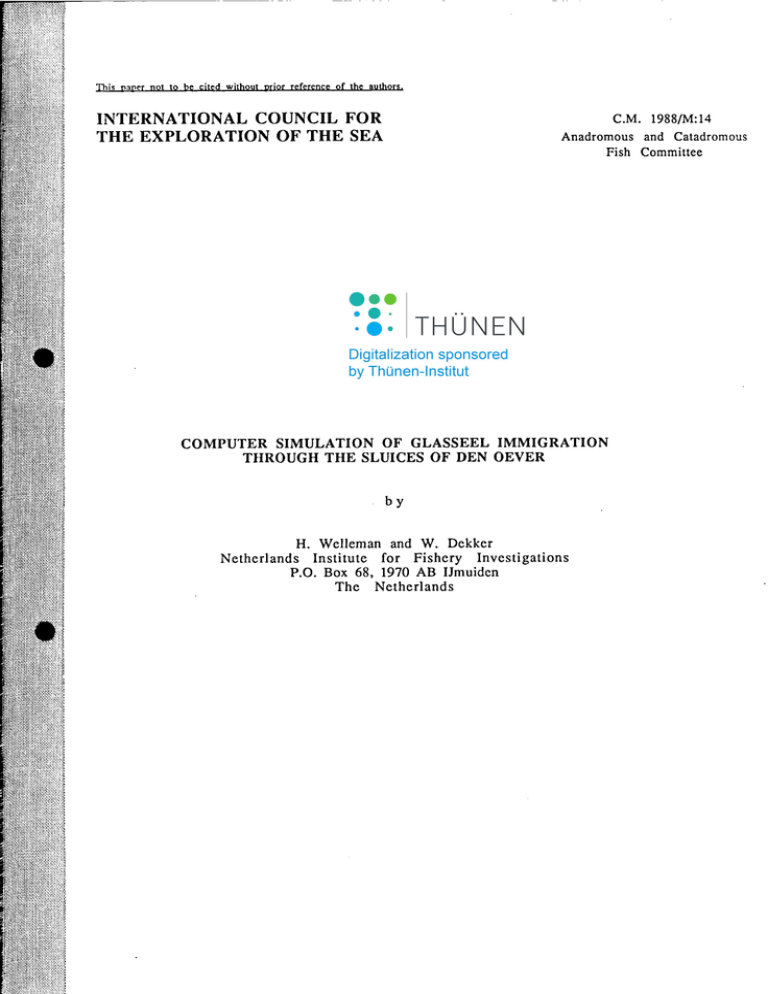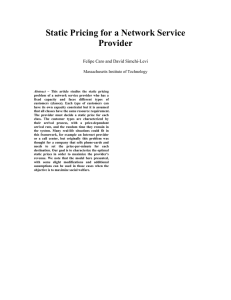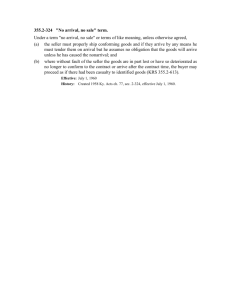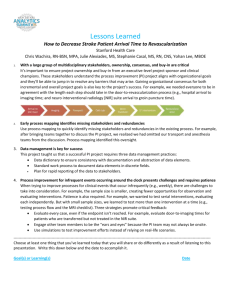INTERNATIONAL COUNCIL FOR THE EXPLORATION OF THE SEA by oe
advertisement

,-------------
- - - - - -
Ibis paper not to be cited wjthout prior reference
oe
the aUlboTS.
INTERNATIONAL COUNCIL FOR
THE EXPLORATION OF THE SEA
C.M. 1988/M:14
Anadromous and Catadromous
Fish Committee
COMPUTER SIMULATION OF GLASSEEL IMMIGRATION
THROUGH THE SLUICES OF DEN OEVER
by
H. Welleman and W. Dekker
Netherlands Institute for Fishery Investigations
P.O. Box 68, 1970 AB IJmuiden
The Netherlands
To be cited without prior reference to the author.
-.
ICES C.M. 1988/M:14
Anaent commiuec
Computer simulation of glasseel immigratiori
through the sluices of Den Oever.
by Henny Welleman and Willem Dekker ,
Nctherlands Institute for Fishery Investigalion
P.O. box 68, 1978 AB, IJmuiden, Netherlands.
Abstract
•
on
BasCd
ralher straightforward assumptions (peak arrival time, constant probability of successful
immigration or normally distributed pass through delays), the density of immigrating glasseels (Anguilla
anguilla) just iri front of sluices are simulaied, and parameter estimates tuned to 50 years ofdata. Contrary to
former believes, it is shown that peak arrival times secm to occur early in the evening, and peak pass through
.
.
late at night. Decisive experiments ure stiggestCd.
Rcsume
. Avcc des suppositions simples (Ie lemps des arrivCe culminant, probabilite de, immmigration reussie
constante, ou des retards distribue normal) le densite des civeIIes (Anguilla anguilla) immigrantcs en eau douce
devant les ecluses sont simule, et les parametres ajuste a 50 ans des donnees de Den Oever. Contrastant avcc des
convictioris precedents, le temps de arrivCe culminant sembled'ctre du soir ct pas de la nuit, et le temps de
immigration bien avant dans le grand matin. Des experiences cruciales sont propose.
I
Introduction
,
•
The reproduction of the European eel is stiÜ imknown (Boctius and Harding, 1985). Thus, the exact identity
of the stock is difficult to dclimit. Whatever the true identity, it secms beyond doubt, that the whole of western
Europe shares at least p:irt of the spawning stock. Thus, the dccline in rccruitment in recent yearS in many
European countries (Moriarty, 1987) is a common concern, arid monitoring the recruitment of. common interest.
In a recent review of glasseel monitoring in Europe (Moriarty, et al., 1987) it is shown, that most recruitment
surveys are of a rather crt.ide nature: only total catches per night,or even per year are monitored, sometimes
even corrupted by varying (commercial) sarnpling effort. Only one data series gives finer detail: in Den Oever
(Netherlands), every two hour during nights in spring, gIasseels in front of the sluices disCharging water from
sampled with a dipnet. Additionally, Den Oever is the only series which did show an earlier
the IJsselmeer
decline in recruitment -in the early fifties- since other reries do not extend backwards far enough. Thus, the
correct interpretation of the Den Oever time series is of utmost impoftance.
On the other side, monitoring of glasseel immigration throughout EuroPe takes place in estuaries and river
mouths, except for theDen Oever site , whcre sampIes are taken in front of sluices, which separate sea from "
frcsh water. Thc comparlson of the data collected at this site with the rest of Europe, might be corrupted by the
stccp transition from sea to fresh water. In Den Oever, the standing density of glasseels in front of the sIuices is
sampled; this density MS been taken to be an index of the flow of glasseels through the sluices (Deelder, 1958).
Howcver, if glasseels dclay their migration just in front of the sluices (in order to adapt to the changing abiotic
environment, or because of the low chance of successful passage through the sluices), the relationship between
standing density and flow through might dcpend on variable abiotic factors like water temperature and salinity
of both water masses.
.' .
. .
..' . .
'.
In an earlier, descriptive analysis (Dekker, 1986) 50 years of data of the Den Oever series wem analysed,
and correlations with abiotic, factors detected. However, although the dependence of the standing .density on the
migration speed was acknowledged, no historiCal data were at hand to make any actual estimate. In order to
prepare for future experiments, the present study simulated the assumed effect of physiologiCal or abiotic
constraints on migration speed on the recording of glasseel densities.
are
1
-.
Simulation models
.
.
"
..
,
,
In the current study, the dynamics of the glassccl migration at the. sampling location in front of the sluices in
the course of average night was simulatcd. This location was thought 10 be bounded by an imaginary bordcr
bctween the estuary and the vicinity of the sluices at the
side, and the sluices thcmselves at the fresh watcr
side. For thrce diffcrcnt assumptions about the actual delay mechanism each, only one simulation was sct up,
Le. no distinction was made bctwecn carly and late spring, small and big watcr dischargcs, or stccp and mild
transitions of abiotic factors, etc.
an
sca
The models wefe bulId upon the following assumptions:
I) Time interval. SirilUlations were made using discrete time intervals. These intervals were laken to be
either 0.5, I or 2 hours. Within one interval, it is assumed that nothing happens.
•
•
2) Average arrival time of glassccls from the estu3ry. It was assumed that all glasseels aim at some
optimum arrival time, but that a grcat number of mndom factors do actually divert them from this unknown
optimum. Thus, the arrival time will be normally distributed Mound the optimum, with an unknown spread,
charactcrized by the two paramctcrs mean arrival time and spread in arrival time (mean and standard
- deviation).
3) Actual number of arriving glasseels from the estu:Üy. In the preccding section, the average numbers
arriving from the estuarywere specificd. The actual number amving per time interval was laken to be random
sampIe from a Poisson-distribution having the avcrage specified in the preccding section as its expectation. This
Poisson-distribution corrcsponds 10 thelog-transform of the historical data used in Dekker, 1986. Tuning of the
models and gencrating the output was done on the mean of 10-1000 Monte Carlo runs. The number of Monte
Carlo runs was laken as the minimum having no significantly differing results from much bigger numbers.
a
4) l\iigratlon delay lust in front of the sluices. It is assuined that the aciual migration delays in the vicinity of
the sluiccs. This delay might be determincd by factors controlled by the glassccl itself (e.g. physiological
adaptation 10 changing abiotic factors) or might be caused by unfavorable external factors (e.g. high water
vclocities in the sluices making the swimming effort little successful). Thus, two alternative modules were
developed:
.
41) Internal factors control the delay. In thiS situation, the moment the migration continues will depend on
the arrival time of the glassecl, and thus each group of glassccls with the same arrival time was simulated
separately. The adaptation was assumed to start slowly, to peak around some average, and to finish again
slowly, quantificd in a .Verhulst-function with parameters mean_adaptation_duration and adaptation_spread
(mean and interval to adapt the second or third quartile).
,
4E) External factors control the delay. In this situation, all available glassccls get the same chance of
success. It was assumcd that each glassccl should acquire a minimum number of successcs, to pass the sluices.
This minimum was arbitrarily chosen to be 1,3 or 10, generating thrcc different versions of this model.This
number is referrect to as number_oLbottle_necks. The chance per glasseel of successful passage of a single
bottle neck was namcd passage chance. .
' . ' .
, .
.' '
In cases with number 01 bOltle neck$> I, it was arbitr3rlly decidcd to force glassccls 10 wait til the end of a
successful interval, before the next bottIe neck could be tricd. This assumption corresponds 10 the notion of a
very fatiguing bottle neck passage, but with the longest time intervals it might force a somewhat irrcalistic
'delay.
The different model options will be coded as 41 (internal) and 4EI, 4E3 and 4ElO (exiernal, # boitIe necks) .'
in the following.
ResuIts
a
, The model building blocks deseribCd in the previous paragraph were written out in Pascal proiram,and
run on a micro-VAX-2 undcrVMS-4.3~ Unknown parameters were fitted 10 match the results of the historical
data analysis (Dekker, 1986, hour-effcct) as closely as possible, using .a discrete Newton-Raphson algorithm.
Results are presented as estimated parameter values. and as predicted quantities of glassccls expressed as
fractions of the total immigration per night. Estimated variances and covariances are derived from finite
difference quotient approximations..
.
. ' . . ...
'
, Table 1 presentS the parameter estirriates for most of the ßwdel options. Since some of the options did not
influence the outcomes significantly, not all resultS are presented in {ull detail. Tbe choice of the time interval
2
-
------------------------
tumed out to be rather irrelevant; thus, a 1 hour interval was usCd thfoughout. Likewise, the number of Monte
Carlo runs had no effcct down to as fewas 10 runs iri some cases. A&,ain, a uniform size of 50 was preferroo.
Figures 1 through 4 present the simulated data more comprehensively. Figure 1 shows that, under the
assumption of an internal delay mcchanism. the observations are best simulatOO when arrival peaks early in the
evening. has nearly stopped around midnight, while the pass through rcally starts around midnight, and peaks in
the late night. Using the external control assumption (fig 2-4) produces almost the same pictui-e, if the
number o[ boule necks = 3. With a greaternumber o[ boule necks, arrival inoves towards the aftemoon,
while a smäiler number shirts the arrival 10 ihe mid-evening. Accordingly, many bottle_nccks retards the pass
through to late nighL
Discussion
•
In the current study, the hypothesizoo iminigration delay of glasseels in front of the sluices at Den Oever was
.
simulated. First we consider the simulation model adequacy, then the relevance 10 glasseel studies.
The simulation models usOO were purposely constructOO from as simple assumptions as possible. However,
almost no information on actual quantities and relationships is available. ·Thus, the present assumptions should
be considered as first guesses.
' . '.
,
Firstly, the model assumptions have been selccted to be simple, but realistic. In retrospect, we have some
doubts whether analytieal derivations of deterministie models instead of Monte Carlo simulations would not
have derived the same resultS mueh more chcaply. But this would not have affccted the outcomes seriously.
The normally distributed arrival times seem reasonable in having a peak in the evening, coming to zero
before and afterwards. However, it is rather dubious whether this function should have been chosen
symmetrleally, Le. the incline before the peak taking exactly the same time as the dccline afterwards. In fact,
using model option 4EIO, estimates indicate that arrival peaks Mound 15.00 in the afterrioon. This result
undoubtedly is an artefact caused by the historical sampling scheme: since afternoon sampIes never cateh any
glasseels, no sampies have historically been laken at this hour; thus, there was no penalty on assuming non-zero
catehes in the afternoon. Obviously, rapid incline in the early evening, imd a gradual slowing down of the
arrival would have been inore probable.
The keystone of the simulations was the delay mcchanism. Since this simulation study precedes field
experiments, absolutely no information was available on relevant characteristics of the delay mechanism. Thus,
two classes ofdelay mcchanisms (internally and externally controllOO) were trled. For externally controlled
delays, with several bottle_nccks, it was dccidOO on almost no grounds to considef the passage of only one
bottle_neck per time intervaI. This assumption forced long delays in cases with many bottle_necks, thereby
converging the internally andexternally control mechanisms. Probably, externally controlled pass through
without forced delays would have coverOO the scope of possible models heUer.
At the bottom line, we note that studying several model options and wide rariges of parameter values resultOO
in 4 figures, which essentially indicate. the same outcome: glasseel arrival probably does not peak around
.
. .
midnight, but early in the evening, and pass through late in the nighL
Finally, tuming towards the interpretation of glasseel statistics, it is notOO that simulation studies can not
reveal the actual truth; merely, they can show alternative interpretations do explain observationsequally well.
The Den Oever time series covers more than half a century, with numerous publications basOO on it. The
c1assical interpretation of the daily cateh curve is, that glasseels concentrate their migration on fresh water
discharging sluices (Deelder, 1952, p 204), peak their passage around midnight (Deelder, 1952, p 197), and hide
in or near the hoUom as soon as they have entered the fresh water system (v. Heusden, 1943)•
. This paper claims that exaetly the same observations ean be interpretOO more simply, by assuming migration
delays just in front of the sluices. If glasseels coneentrate at any sluice expelIing inland water (salt or fresh),
principally arriving early in the evening, but dclaying their pass through just in front of the sluices (resulting in
incrcased densities ofup to tenfold the initial density) till the late night, after which they continue their migration
(Le. no inercased densityat the fresh water side of the sluiees), all observations have been eoverOO equally well. :
However, the consequenceof this alternative interpretation is, that - sinee delay intervals may vary in length - .
monitoring the standing densities in front of the sluices can not adequately reflect the actual migration intensity. '. f
Obviously, actual field experiments are required. Monitoring glasseels in front of fresh water discharges .
which can not be passed by glasseels (e.g. water overflow systems) - eitherby cateh Per unit effoet tcchniques or
by dilution of marked population essays - inight give some clue to the aetual arrival time, and thus indirectly of
the aetual delay of glasseels dunng the nighL
a
•
3
I
l
Literature
-Boetius, J., and Harding. E.F., 1985, A re-examination of Johannes Schmid'tls Atlantic eel investigations. Dana 4:129-162
-Deelder, C.L., 1952, On the migration of the elver (Anguilla vulgaris Turt.) at sea. J.Cons.Int.Exp.Mer 18(2):187-218.
-Deelder, C.L., 1958 - On the behavior of elvers (Anguilla vulgaris Tun.) migrating from the sea into fresh water.
1. Cons. Perm. Explor. Mer, 24(1):136-146.
-Dekker, W., 1986, Regional variation in glasseel catches; an evaluation of multiple sampling sites. Vie et Milieu 36:251-254.
-Heusden, G.P.H. v., 1943, De trek van den glasaalnaar het IJsselmeer. Thesis. Enschede, Haarlem, The Netherlands. 152 pp.
-Moriarty, C., 1987, Observations on elver catches at European stations. EIFAC working party on eel, Bristol, April 1987.
-Moriarty, C., Dekker, W. and Elie, P., 1987, Elver stocks: a critical assessment of previous studies and proposals for future
monitoring. EIFAC working party on eel, Bristol, April 1987.
Table 1.
Estimated parameter values for all simulated models.
•
41
model option
mean arrival time
spread_in_ar'rivaUime
mean_adaptation_duration
adaptation_spread
numer_01_boule_necks
passage_chance
18.21
3.16
7.16
2.42
±
±
±
±
0.02
0.02
0.14
0.27
4El
4E3
4ElO
20.42 ± 0.01
3.55 ± 0.02
19.37 ± 0.01
4.19 ± 0.02
15.07 ± 0.02
5.06 ± 0.02
1
0.23 ± 0.0
3
0.37 ± 0.0
10
0.58 ± 0.0
•
4
Figure 1
Simulated results on arrival frequency, standing density and pass through using model option 41, i.e. internal
control.
25
20
15
10
arrival
emigration
5
present
•
o
1
·2
3
4
5
6
7
houe
Figure 2
Simulated results on arrival frequency, standing density and pass through using model option 4EI, Le. external
control, with only one boule neck to be passed.
%
25
•
20
15
10
arrival
emigration
5
present
0
19
-5
20
21
22
23
0
1
2
3
4
5
6
7
houe
-10
-15
5
-.
Figure 3
Simulated results on arrival frequency, standing density and pass through using model option 4E3, i.e. external
control, with three boule necks to be passed.
%
25
20
15
10
arrival
emigration
5
present
•
0
0
19
1
2
3
4
5
6
7
hour
-51
-10
-15
Figure 4
Simulated results on arrival frequency, standing density and pass through using model option 4EI0, i.e. external
control, with ten bottle necks to be passed.
%
25
•
20
15
10
arrival
emigration
5
present'
0
19
20
21
3
4
5
6
7
-5
-10
-15
6





